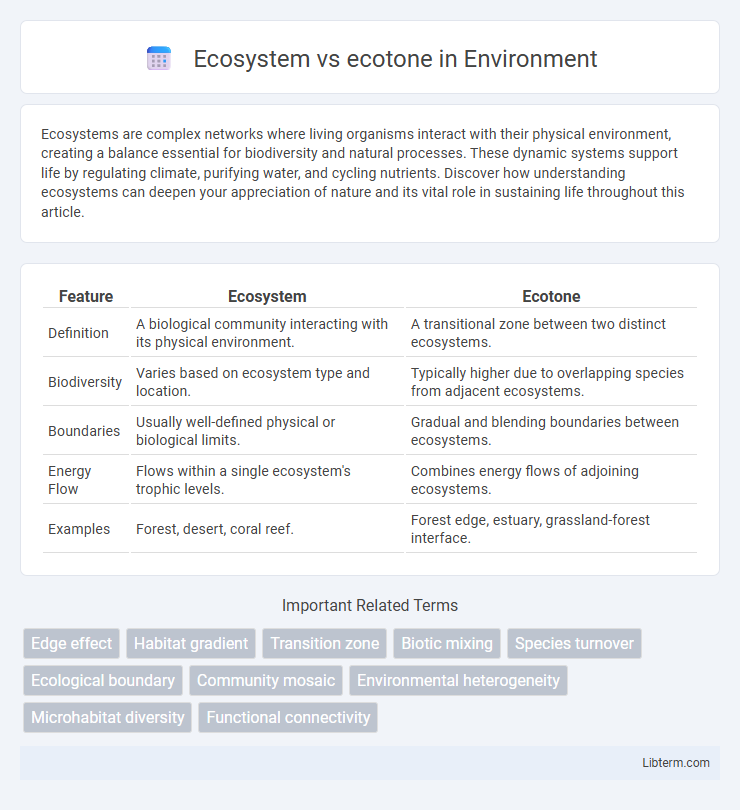Ecosystems are complex networks where living organisms interact with their physical environment, creating a balance essential for biodiversity and natural processes. These dynamic systems support life by regulating climate, purifying water, and cycling nutrients. Discover how understanding ecosystems can deepen your appreciation of nature and its vital role in sustaining life throughout this article.
Table of Comparison
| Feature | Ecosystem | Ecotone |
|---|---|---|
| Definition | A biological community interacting with its physical environment. | A transitional zone between two distinct ecosystems. |
| Biodiversity | Varies based on ecosystem type and location. | Typically higher due to overlapping species from adjacent ecosystems. |
| Boundaries | Usually well-defined physical or biological limits. | Gradual and blending boundaries between ecosystems. |
| Energy Flow | Flows within a single ecosystem's trophic levels. | Combines energy flows of adjoining ecosystems. |
| Examples | Forest, desert, coral reef. | Forest edge, estuary, grassland-forest interface. |
Introduction to Ecosystem and Ecotone
An ecosystem consists of a community of living organisms interacting with their physical environment, forming a complex web of energy flow and nutrient cycling. An ecotone is a transitional zone where two distinct ecosystems meet and integrate, exhibiting characteristics of both adjacent systems. This boundary area often supports higher biodiversity due to the mix of species from the neighboring ecosystems.
Definition of Ecosystem
An ecosystem is a dynamic, complex community of living organisms interacting with each other and their physical environment, functioning as a single ecological unit. It includes biotic components (plants, animals, microorganisms) and abiotic factors (climate, soil, water) that influence energy flow and nutrient cycles. In contrast, an ecotone is a transitional zone between two adjacent ecosystems, characterized by unique species composition and environmental gradients.
Definition of Ecotone
An ecotone is a transitional zone between two distinct ecosystems or ecological communities, characterized by a high level of species diversity and unique environmental conditions. Unlike an ecosystem, which is a stable, self-sustaining biological community interacting with its physical environment, an ecotone represents a boundary where species from adjacent ecosystems coexist and interact. This blending of habitats often results in increased biological productivity and enhanced ecological interactions.
Key Characteristics of Ecosystems
Ecosystems are defined by the interaction of living organisms with their physical environment, featuring key characteristics such as energy flow, nutrient cycling, and biotic diversity. They maintain stability through balanced trophic levels and ecological processes that sustain species populations and habitat conditions. Unlike ecotones, which are transitional zones between ecosystems, ecosystems possess distinct boundaries and self-regulating mechanisms crucial for ecological integrity.
Key Features of Ecotones
Ecotones are transitional zones between two distinct ecosystems, characterized by high biodiversity and unique species interactions not found in the adjacent ecosystems. Key features of ecotones include increased species richness, edge effects that influence microclimate and nutrient cycling, and ecological gradients that create diverse habitats. These zones act as ecological buffers and hotspots for evolutionary processes, differing fundamentally from the relatively stable environments of interior ecosystems.
Types of Ecosystems
Ecosystems are categorized into terrestrial, aquatic, and artificial types, each characterized by unique interactions between organisms and their physical environment. Terrestrial ecosystems include forests, deserts, and grasslands, while aquatic ecosystems encompass freshwater and marine environments. Ecotones, transitional zones between ecosystems, exhibit species diversity from both adjoining ecosystems, often supporting unique communities not found in the neighboring ecosystems.
Types of Ecotones
Ecotones represent transition zones between two distinct ecosystems, characterized by unique environmental gradients and increased biodiversity compared to adjacent areas. Types of ecotones include edge ecotones, occurring at the boundary of two ecosystems like forest and grassland; gradient ecotones, where gradual changes in abiotic factors create a continuous transition; and sharp ecotones, marked by abrupt shifts in species composition and physical conditions. These ecotone types play critical roles in species migration, habitat diversity, and ecological resilience within broader ecosystem dynamics.
Differences Between Ecosystem and Ecotone
An ecosystem consists of a community of living organisms interacting with their physical environment as a single functional unit, while an ecotone is a transitional zone between two distinct ecosystems where species from both overlap and interact. Ecosystems have relatively uniform environmental conditions and species composition, whereas ecotones display greater biodiversity and environmental gradients due to the mixing of habitats. Ecotones often serve as critical areas for ecological processes such as species migration, adaptation, and resource exchange that do not occur as prominently within individual ecosystems.
Ecological Importance of Ecotones
Ecotones are transitional zones between two distinct ecosystems where species from both habitats coexist, leading to high biodiversity and unique interactions. These areas serve as critical regions for ecological processes such as nutrient cycling, habitat connectivity, and species migration corridors, enhancing overall ecosystem resilience. The presence of diverse microhabitats in ecotones supports specialized species and contributes significantly to ecological stability and conservation efforts.
Conclusion: Ecosystem vs Ecotone
Ecosystems represent stable, self-sustaining communities of interacting organisms and their physical environment, while ecotones are transitional zones where two or more ecosystems converge, exhibiting high biodiversity and unique species compositions. The dynamic nature of ecotones often results in greater ecological complexity and resilience compared to individual ecosystems. Understanding the distinctions between ecosystems and ecotones is crucial for effective conservation strategies and ecosystem management.
Ecosystem Infographic

 libterm.com
libterm.com